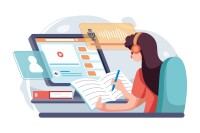Search
There are 11 results.
Tag
Tag
All (124)
Active Learning (4)
Activities (4)
Alt Text (2)
Analytics (4)
Animations (1)
Assessments (7)
Asynchrony (6)
Authentic Activities (2)
Backwards Design (2)
Belonging (3)
Canvas (10)
Case Studies (2)
Collaboration (5)
Color Contrast (2)
Communication (8)
Community (7)
Content Creation (12)
Copyright (2)
Course Maintenance (5)
Course Materials (7)
Course Preparation (6)
Discussions (5)
Diversity (5)
Equity (2)
Faculty Presence (3)
Faculty Support (2)
Feedback (8)
Formative Assessments (6)
Game-Based Learning (2)
Gamification (1)
Generative AI (2)
Grading (5)
Group Work (2)
Hyperlinks (1)
Images (3)
Inclusion (6)
Infographics (2)
Learning Objectives (3)
Multimodality (7)
Page Design (2)
Peer Review (1)
Podcasts (1)
PowerPoint (2)
Presentations (2)
Qualitative courses (1)
Quantitative courses (1)
Representation (1)
Revising (2)
Rubrics (4)
Scaffolding (1)
Screen Readers (1)
Social Media (2)
Summative Assessments (1)
Synchrony (8)
Third-Party Tools (2)
Universal Design for Learning (UDL) (2)
Video (12)
Visual Accessibility (2)
Visual Design (2)
Workload (1)
Written Assignments (1)
No Sweat Alt Text
What is “alt text”? Alt text is descriptive text linked to an image, graph, or other visual content that allows users to understand the visual without viewing it. Any image online should contain alt text, but guidelines differ depending on whether the image is simply decorative or related to other content on the page.
Enhancing Quantitative Courses With Varied Learning Approaches
Employing a variety of modes of instruction and assessment, as recommended by Universal Design for Learning (UDL) principles, can enhance the learning experience for students in quantitative courses. Diverse elements such as visual aids, interactive features, and real-world applications can complement, extend, or replace traditional lectures and exams. Since classes consist of students with varying learning preferences and strategies, using multiple modes of representation in a course promotes deeper understanding, engagement, and skill development. This piece details design elements that can be particularly impactful in quantitative courses.
Accessible PDFs
Developing and delivering accessible instructional content—meaning content that students with and without disabilities can readily engage with and use—is essential to the success of an online course. While many accessibility standards and guidelines are broadly applicable, there are also specific considerations unique to different content formats and delivery modes. In this piece, we present recommendations for enhancing the accessibility of PDFs for students.
Accessible Use of Text
Students with diverse cognitive, linguistic, and academic abilities benefit from accessible text. The Web Content Accessibility Guidelines (WCAG) establish numerous requirements (known as success criteria) to ensure that text is perceivable, operable, and understandable to all users. This guide synthesizes the essential criteria related to text accessibility. Following these guidelines when creating course content, such as documents, slides, and pages in the LMS, will help you eliminate potential barriers for your learners.
Inclusive Texts
Today’s students are diverse and include marginalized groups that have historically been excluded from mainstream education (Ladson-Billings, 2013). In 2021, students of color comprised upwards of 40% of the 15.4 million undergraduates enrolled in U.S. colleges and universities (Nam, 2023; National Center for Education Statistics, 2023). Gloria Ladson-Billings, whose work centers on culturally relevant pedagogy, argues that diverse students require inclusive learning to succeed. “[These students] do not fit neatly into the rigid categories of race, class, gender, or national origin” upon which hierarchies of the past have been built (Ladson-Billings, 2013, p. 5), so authentic representation of diversity in higher education is critical. Adrienne Keene, an assistant professor of American Studies at Brown University, writes that instructors can do their part to support underrepresented students by being honest about their own bias and blind spots, critiquing their course materials, and integrating meaningful representations of diversity into the curriculum (Fuchs et al., 2020; Keene, 2015).
Developing Instructional Materials
Once you have defined the learning objectives for your course, you can begin to develop assessments to ensure students achieve those objectives. Once you have created assessments, you can begin to develop materials to ensure students succeed on those assessments. This backward design process—which moves from objectives to assessments and finally to materials—is known as learning-centered instruction, and it directs every course task toward the mastery of certain skills and competencies. This blog focuses on the third stage of this process, the development of high-quality instructional materials, beginning with the idea that robust and engaging online courses contain a mix of created and curated content. Below you will find guidelines for creating and curating instructional materials to help you achieve the optimal balance for your course.
Leveraging Podcasts in Online Higher Education
Podcasts are digital audio that you can download or stream onto a computer or mobile device. They are convenient, portable, reusable, and do not require particularly high-tech devices or connections. They are also popular. According to a 2022 Infinite Dial survey, "Seventy-three percent of the U.S. 12+ population (an estimated 209 million people) have listened to online audio in the last month, up from 68% in 2021" (Edison Research, 2022). While podcast use declined slightly in 2022, returning to pre-pandemic levels, the medium is still burgeoning, with plenty of room for further growth.










